May 2019 Science and Technology
Sakshi Education
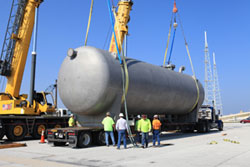
- Liquid hydrogen storage tank launched
ISRO Chairman K Sivan flagged off the shipment of India's largest liquid hydrogen storage tank at the VRV Asia Pacific's manufacturing plant at Sri City in Chittoor district of Andhra Pradesh.
VRV Asia Pacific manufactured the storage tank with a Liquid Nitrogen shield, in a collaborative effort with Satish Dhawan Space Centre.
Liquid hydrogen is used as fuel for satellite launch vehicles.
- NewSpace India officially inaugurated
NewSpace India Limited (NSIL), the commercial arm of Indian Space Research Organisation (ISRO), was officially inaugurated in Bengaluru on 23 May 2019.
NSIL's main objective is to scale up industry participation in Indian space programmes.
NSIL will act as an aggregator for all space-related activities in industry and develop private entrepreneurship in space-related technologies.
- NASA unveils schedule for 'Artemis'
NASA unveiled the schedule for the 'Artemis' program that will return astronauts to the Moon, including eight scheduled launches and a mini-station in lunar orbit by 2024.
Artemis 1 will be an uncrewed mission around the Moon planned for 2020.
Artemis 2 will orbit the moon with a crew around 2022; followed finally by Artemis 3 that will put astronauts on lunar soil in 2024.
- DRDO successfully flight tested Inertial Guided Bomb from an Su-30 MKI aircraft
Defence Research and Defence Organisation (DRDO) successfully flight tested a 500 kg class Inertial Guided Bomb from a Su-30 MKI aircraft at the Pokhran test range in Rajasthan.
The indigenously-developed guided bomb achieved the desired range and hit the target at a distance of 30 km away with high precision.
All the mission objectives have been met. The weapon system is capable of carrying different warheads.
India has carried out several such trials in 2019. DRDO is engaged in developing defence technologies covering various disciplines.
The test firing of the guided bomb comes two days after the Indian Air Force (IAF) successfully test fired the aerial version of the supersonic BrahMos cruise missile from a Sukhoi jet at the Andaman and Nicobar Islands.
The 2.5-tonne air-to-surface missile has a range of around 300 km, and it will significantly enhance the IAF's combat capability.
- ISS spacewalk successfully carried out for the 217th time by 2 cosmonauts
Two Russian space agency Roscosmos' cosmonauts have successfully carried out the 217th spacewalk for International Space Station's support, maintenance and upgrade.
The spacewalk, fourth for 2019, was done by Expedition 59 Commander Oleg Kononenko and Flight Engineer Alexey Ovchinin and lasted six hours and one minute.
This was Commander Kononenko's fifth spacewalk and the first-ever for Ovchinin.
The cosmonauts retrieved science experiments, install handrails on the Russian segment of the complex, and conduct maintenance on the orbiting laboratory.
- NASA plan to send equipment to Moon from 2020
NASA has chosen Astrobotic, Intuitive Machines and Orbit Beyond to send equipment to the Moon.
Donald Trump has accelerated the timetable for putting humans back on the Moon with 2024 the new target date.
Each company has developed lunar landers of different sizes and shapes: one is tall, and the other two are more compact.
- ISRO partnered with IAF for Gaganyaan astronaut selection, training
The Indian Air Force (IAF) has signed an agreement with the Indian Space Research Organisation (ISRO) for crew selection and training for the prestigious Gaganyaan, the country's maiden manned mission.
AVM RGK Kapoor, ACAS Ops (Space), IAF handed over the MoU to Shri R Hutton, Project Director of Gaganyaan Programme.
Under the programme, a three-member crew will spend a minimum of seven days in space.
A human-rated GSLV Mk-lll will be used to carry the orbital module, which will have necessary provisions for sustaining a three-member crew for the duration of the mission.
The Institute of Aerospace Medicine (IAM) will lead the selection and training of astronauts on behalf of IAF.
The necessary infrastructure for crew training, a realization of flight systems and ground infrastructure will be established to support the program.
The ISRO will collaborate extensively with national agencies, laboratories, academia, and industry to accomplish the objectives of the prestigious mission.
- RISAT-2B to be launched on May 22 from Sriharikota
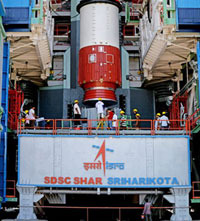 RISAT-2B, the satellite due to be launched before dawn on May 22 from Sriharikota, will mark the resumption of a vital ring of Indian all-seeing radar imaging satellites after seven years.
RISAT-2B, the satellite due to be launched before dawn on May 22 from Sriharikota, will mark the resumption of a vital ring of Indian all-seeing radar imaging satellites after seven years.
At least a half-dozen could be foreseen in the near future, mainly to add to the reconnaissance capability from about 500 km in space. A constellation of such space-based radars means a comprehensive vigil over the country.
Many RISATs were planned. RISAT-2B is to be followed by RISAT-2BR1, 2BR2, RISAT-1A, 1B, 2A and so on.
If ISRO orbited its first two radar satellites in 2009 and 2012, it plans to deploy four or five of them in 2019 alone.
When it is cloudy or dark, ‘regular’ remote-sensing or optical imaging satellites — which work like a light-dependent camera — cannot perceive hidden or surreptitious objects on the ground.
Satellites that are equipped with an active sensor, the synthetic aperture radar (SAR), can sense or ‘observe’ Earth in a special way from space day and night, rain or cloud. This all-weather seeing feature is what makes them special for security forces and disaster relief agencies.
“Radar imaging satellites are at a premium in the Earth observation scene.
“Worldwide, quite a few of them are planned to be launched.
There is also a large availability of radar images data in the market.”
- NASA's new robot got 1st hardware check
Astrobee, a free-flying robot system has had its first hardware checks on the International Space Station.
The system is actually a trio of robots, named Honey, Queen, and Bumble, which are propelledby electric fans.
They can return to their docking station to recharge their batteries.
- Evidence of water found on Ultima Thule
NASA has found evidence for a unique mixture of methanol, water ice, and organic molecules on Ultima Thule’s surface-the farthest world ever explored by mankind.
Researchers are also investigating a range of surface features on Ultima Thule, such as bright spots and patches, hills and troughs, and craters and pits.
- ISRO announced 7 missions in next 10 years
ISRO has announced to conduct 7 Mega Missions for the upcoming 10 years and also prepared a roadmap for the next 30 years.
The 7 Mega Missions includes India’s second moon mission Chandrayaan-2, XPoSaT and Aditya L-1.
ISRO categorized its six Mega Missions (excluding Chandrayaan-2) in two broad categories- Defined Missions and Undefined Missions.
- ISRO launches earth observation satellite RISAT-2B
Indian Space Research Organisation has successfully launched its earth observation satellite RISAT-2B from Sriharikota.
ISRO's trusted workhorse PSLV-C46 carrying RISAT-2B blasted off from the Satish Dhawan Space Centre at 5:30 this morning.
The 615 kg satellite was released into the orbit 15 minutes after the lift-off. RISAT-2B meant for application in fields such as surveillance, agriculture, forestry and disaster management support. It will replace the RISAT-2, which was launched in 2009.
This particular mission is really important in the sense that PSLV has crossed a landmark of launching 50 tonnes into space.
There are several new features in RISAT-2B. Dr Sivan said, it is having expanded Synthetic Aperture Radar (SAR) making it an advanced earth observation satellite, operating in spotlight mode, mode and mosaic mode.
- IAF successfully fires BrahMos air version missile from frontline Su-30 MKI fighter aircraft
Indian Air Force today successfully fired the BrahMos air version missile from its frontline Su-30 MKI fighter aircraft.
The launch from the aircraft was smooth and the missile followed the desired trajectory before directly hitting the land target.
The air launched BrahMos missile is a 2.5 ton supersonic air to surface cruise missile.
The Inidan Air Force became the first Air Force in the world to have successfully fired an air launched 2.8 Mach surface attack missile of this category on a sea target on Novemebr 2017. Today’s was the second such live launch of the weapon.
The BrahMos missile provides Indian Air Force a much desired capability to strike from large stand-off ranges on any target at sea or on land with pinpoint accuracy by day or night and in all weather conditions.
- Moons' formation brought water
A cosmic body that hit the Earth and led to the formation of the Moon about 4.4 billion years ago may have also delivered large quantities of water to our home planet, scientists have found.
The Earth is the only terrestrial planet with a large amount of water and a relatively large moon, which stabilises the Earth's axis.
Both were essential for Earth to develop life.
- Brahmos missile successfully fired
IAF successfully fired the BrahMos air version missile from its frontline Su-30 MKI fighter aircraft.
The launch from the aircraft was smooth and the missile followed the desired trajectory before directly hitting the land target.
The air-launched BrahMos missile is a 2.5- ton supersonic air to surface cruise missile with ranges of close to 300 km.
- SpaceX launches first satellites for Musk’s Starlink internet service
High-tech entrepreneur Elon Musk's SpaceX Company launched a Falcon 9 rocket from Florida on 23 May, 2019 on a mission to carry the first batch of five dozen small satellites into low-Earth orbit for his new Starlink internet service.
The rocket blasted off from Cape Canaveral Air Force Station at about 10:30 p.m. local time (0230 GMT Friday), marking a milestone in a global enterprise aimed at generating cash for Mr. Musk's larger ambitions in space.
The Falcon 9 was due to release its cargo of 60 satellites into orbit about an hour after Thursday's (23 May, 2019) launch.
Each one weighs 500 pounds (227 kg), making it the heaviest payload for any SpaceX rocket to date.
Those satellites are designed to form the initial phase a planned constellation capable of beaming signals for high-speed internet service from space to paying customers around the globe.
SpaceX would begin approaching customers later this year or next year. As many as 2,000 satellites will be launched per year, with the ultimate objective of placing up to 12,000 into orbit.
- 18 hidden planets uncovered by NASA
German scientists have discovered 18 Earth-sized planets beyond solar system.
Scientists re-analysed part of NASA's Kepler Telescope data using new method developed by them.
They estimate the method may lead to over 100 more exoplanet discoveries from entire Kepler dataset.
- Scientists broke superconductivity record
International researchers have broken the record for superconductivity at the highest temperature recorded to date at around -23°C.
They created a new material, called lanthanum superhydrides, to achieve the same.
The material was, however, placed under extremely high pressure ranging between 150-170 gigapascals to reach the new record.
- AN-32 certified to operate on Bio-Jet fuel
IAF’s AN-32 aircraft was formally fleet certified to fly on blended aviation fuel containing up to 10% of indigenous bio-jet fuel.
The approval certificate was received at the aero-engine test facilities at Chandigarh by Air Commodore Sanjiv Ghuratia.
This will promote the ‘Make in India’ mission as this bio-fuel would be produced from Tree Borne Oils sourced from tribal areas and farmers.
- Bezos unveiled lunar lander
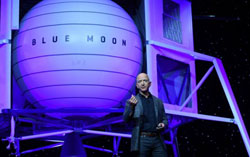 Jeff Bezos unveiled a mockup of a lunar lander being built by his Blue Origin rocket company.
Jeff Bezos unveiled a mockup of a lunar lander being built by his Blue Origin rocket company.
The lander will be able to deliver payloads to the lunar surface, deploy up to four smaller rovers and shoot out satellites to orbit the moon.
Bezos unveiled a model of roughly the size of a golf cart, and presented a new rocket engine called BE-7, which can blast 10,000 pounds (4,535 kg) of thrust.
- ISRO to launch RISAT-2B from Sriharikota on May 22
Indian Space Research Organization ISRO is scheduled to launch the nation’s latest radar imaging satellite RISAT-2B on 22nd May, 2019.
A release from the national space agency says, it will be lifted off by the workhorse rocket PSLV-C46 in its 48th flight.
It will zoom into space from the First Launch Pad of Satish Dhawan Space Centre at Sriharikota, 90 km north of Chennai. The launch is tentatively scheduled at 0527 hrs on the day.
RISAT-2B is a modern radar imaging earth observation satellite. It will be placed in an orbit of 555 km from the earth.
PSLV will fly in 'core-alone' configuration carrying the satellite, without the use of solid strap-on motors. This will be the 72nd launch vehicle mission for ISRO from its spaceport at Sriharikota.
ISRO has made provisions for the general public to view the launch from its recently opened Viewer’s Gallery in the spaceport. They can make online registration for viewing the launch from 5 days before the launch.
- 1st women astronaut to go on Moon
Mission Artemis will likely carry the first woman astronaut to the Moon.
The mission has been named after the Greek Moon goddess who was also the twin sister of the Apollo.
The first men to walk on the Moon did so under the Apollo missions between 1960 and 1972.
Now, 50 years later, NASA has planned to send the first woman to the Moon in a manned lunar mission in 2024.
The moon is shrinking
- The Moon is steadily shrinking, causing wrinkling on its surface and quakes, according to an analysis of imagery captured by NASA’s Lunar Reconnaissance Orbiter (LRO).
- A survey of more than 12,000 images revealed that lunar basin Mare Frigoris near the Moon’s north pole has been cracking and shifting.
- Since the moon’s crust is brittle, these forces cause its surface to break.
- Japan's MOMO-3 rocket reaches outer space
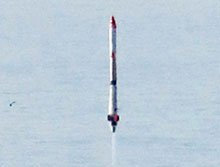 A Japanese aerospace startup funded by a former internet maverick has successfully launched a small rocket into space.
A Japanese aerospace startup funded by a former internet maverick has successfully launched a small rocket into space.
Interstellar Technology Inc. says the unmanned MOMO-3 rocket has exceeded 100 kilometers (60 miles) in altitude before falling into the Pacific Ocean.
The rocket, about 10 meters (32 feet) long and 50 centimeters (1.5 feet) in diameter, weighs about 1 ton.
- India to purchase 10 Kamov-31 choppers
The Defence Ministry approved Indian Navy's proposal to acquire 10 Kamov-31 choppers from Russia at a cost of around Rs 3,600 crore.
It will strengthen its capability against aerial threats to its aircraft carriers and large warships.
The Navy already has a fleet of 12 of these Kamov-31 choppers which sanitize the air space around the aircraft carriers and destroyers operating in open seas.
- SpaceX Launches Falcon 9 Rocket
Space Exploration Technologies Corp. (Space X) launched its 17th commercial resupply mission to the International Space Station by using Falcon 9 rocket with Dragon Spacecraft.
The 213-foot-tall rocket lifted off from Cape Canaveral Air Force Station in Florida.
This mission is a part of NASA’s Commercial Resupply Services program, which uses commercial spacecraft to deliver cargo to the ISS.
- Navy launches 4th Scorpene class submarine
The fourth of Indian Navy’s stealth Scorpene clas Submarines of Project 75 was launched at the Kanhoji Angre Wet Basin of Mazagon Dock Limited at Mumbai in Maharashtra.
The submarine has been named ‘Vela’ after anearlier submarine, which was the lead submarine, of the erstwhile Vela class.
The submarine has completed joining of all its sections.
- ISRO to launch RISAT-2BR1 on 22 May
ISRO is set to launch its Radar Imaging Satellite, the RISAT-2BR1, on May 22, 2019 from Sriharikota in Andhra Pradesh.
The RISAT, a remote sensing satellite, provide all-weather surveillance using synthetic aperture radars (SAR).
RISAT's are the first all-weather observation satellites from ISRO and are designed to provide a continuous view of earth either at day or night.
- SpaceX successfully launched cargo mission
SpaceX successfully launched a Dragon spacecraft on a cargo mission for NASA to International Space Station (ISS).
This is SpaceX's fifth launch of the year.
The launch was rescheduled earlier due to some electrical problem on ISS.
It was launched on a 'Falcon 9' rocket, from Cape Canaveral in Florida. It is being used for the first time.
- Genetic study conducted on Lakshadweep
For the very first-time scientists carried out a genetic study on people of Lakshadweep Islands.
It was conducted by a team of researchers at CSIR's (Council of Scientific & Industrial Research) Centre for Cellular and Molecular Biology (CCMB).
It found the close genetic link of Lakshadweep islanders with people from the Maldives, Sri Lanka, and India.
- NASA to crash spacecraft into asteroid in 2022
In a first, NASA will launch a spacecraft that will collide with an asteroid in 2022 to demonstrate a planetary defense technique.
The Double Asteroid Redirection Test (DART) will get one chance to hit its target, a small moonlet in the binary asteroid system Didymos.
The asteroid poses no threat to Earth.
- Anti-hijack panel revamped
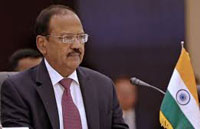 The government of India has revamped its high-level anti-hijack panel to include top officials of the Prime Minister’s Office, especially National Security Advisor Ajit Doval.
The government of India has revamped its high-level anti-hijack panel to include top officials of the Prime Minister’s Office, especially National Security Advisor Ajit Doval.
He will be empowered to coordinate any immediate military response. The panel will be called the Committee of Secretaries on Aircraft Hijack (COSAH).
The panel will be headed by Cabinet Secretary P.K .Sinha.
- Platform for Cryptocurrency Trading launched
BuyUcoin, the second oldest Cryptocurrency Exchange in India, has announced the launch of a new and unique platform for wholesale cryptocurrency trading.
The platform allows its users to trade on a large scale with low price fluctuations. It currently works on free trading model i.e. charges zero fees on any trade.
The platform is aptly described and known as OTC (Over-the-counter) desk.
- Floating nuclear power plant launched
A floating nuclear power plant that is also known as 'Chernobyl on ice' is ready to begin supplying the electricity in Russia.
The Akademik Lomonosov is reportedly destined to provide power for a region in Russia’s far-east.
The ship’s 70-megawatt reactors could power a city of 200,000 people. China is constructing a similar floating power station.
- Chandrayaan-2 modules to be launched in July
All modules of India's second moon mission 'Chandrayaan-2', are scheduled for launch in July 2019.
They are getting ready and the lander is expected to touch down on the lunar surface in early September 2019.
The three modules- Orbiter, Lander (Vikram) and Rover (Pragyan) -- of Chandrayaan-2 are getting ready for July launch.
- ISRO planning to send a probe to study sun early next year
Indian Space Research Organization is planning to send a probe to study the sun early next year (2020).
currently scientists are exploring possibilities to study more about Sun and the probe named Aditya-L1 will be sent to observe the solar corona, the outer layers of the Sun.
The satellite would be ed in a halo orbit around the L1 (Lagrangian point 1) of the Sun-Earth system so that it has the advantage of continuously viewing the Sun without any occultation or eclipses.
The L1 is 1.5 million kms from the Earth. Mr Sivan said, the mission to send Indian astronauts to space by 2022 is well on stream.
About tracking cyclone Fani with the details provided by ISRO, officials were able to forecast the landfall area and this helped in taking precautionary measures in advance.
It may be recalled that ISRO is making all-out efforts to launch Chandrayaan-2 in the launch window between July 9 and 16, with the aim of its lander soft landing near the south pole of the moon by September 6th.
Published date : 15 May 2019 03:03PM



















